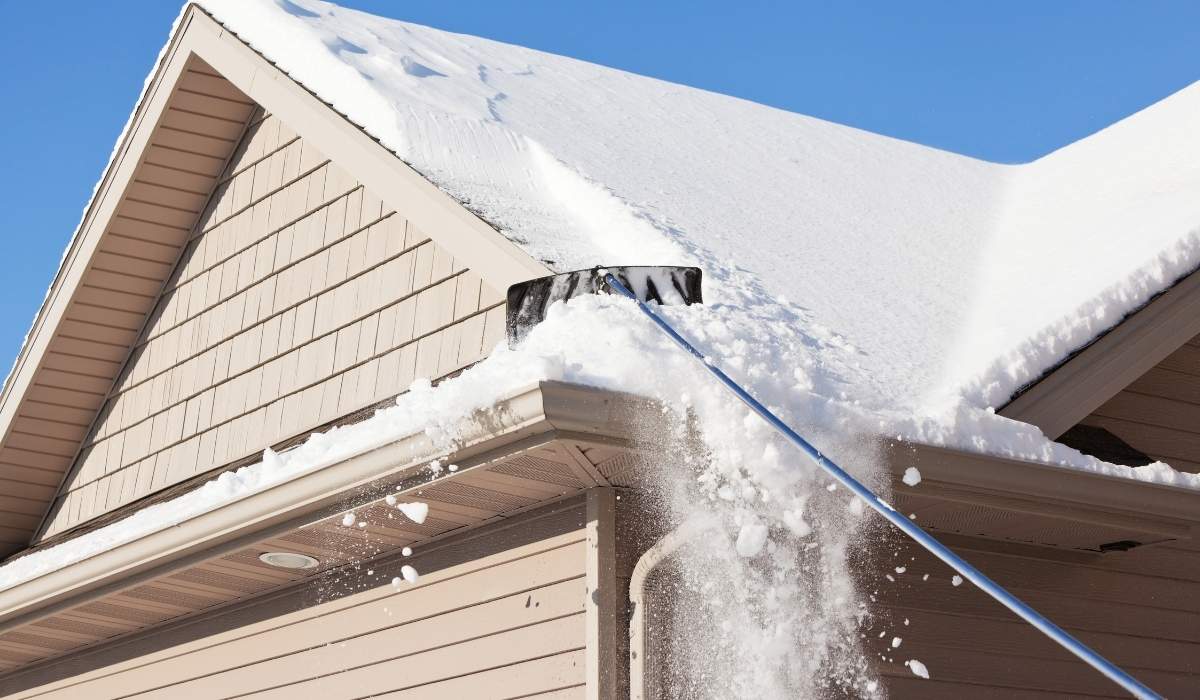Tips for Weather Roof Maintenance : Spring, Summer, & Winter
Your roof is like the superhero of your house. It keeps your family safe from the hot sun, heavy rain, cold Snow, and strong winds.
But just like superheroes need care, your roof needs attention, too! Roof maintenance is important in every season, whether it’s sunny, rainy, snowy, or windy.
In this article, we’ll explore easy tips to keep your roof happy and healthy all year round.
Why Roof Maintenance Is Important
Before we jump into the tips, let’s understand why it’s important to take care of the roof.
- Protects your home: A strong roof keeps your house dry and warm.
- Saves money: Small problems can become big ones if ignored.
- Lasts longer: A well-cared-for roof can last many years.
Tips for Weather Roofing Maintenance
Spring Roof Maintenance
Spring is the season when flowers bloom, birds sing, and the weather becomes warmer. After winter, your roof may need some extra care.
Schedule a Post-Winter Roof Inspection: As winter ends, it’s crucial to have a qualified roofer assess your roof for any damage that may have occurred during the colder months.
Although you can inspect the roof yourself, it’s easy to overlook subtle issues that a trained professional would notice right away.
Additionally, roofs can become slippery and dangerous after winter weather.
For both safety and a thorough assessment, it’s wise to hire an experienced professional to perform the inspection and recommend any needed repairs.
Look for Interior Indicators of Roof Leaks: Exterior roof damage isn’t always obvious. Instead, the inside of your home can offer early clues.
Examine your ceilings for discolored spots or brown, ring-like stains, which often signal a leak.
Also, keep an eye out for peeling or bubbling paint on walls.
If you notice any of these signs, call a contractor to address the damage immediately before it worsens.
Clear Out Your Gutters: Gutter maintenance is a critical part of spring preparation.
During winter, gutters can become blocked with leaves, twigs, and other debris, which hinders proper water drainage.
Clogged gutters can cause water to pool on your roof or overflow, potentially leading to structural issues.
Consider installing gutter guards to reduce the risk of future blockages and improve water flow.
Inspect for Mold and Algae Growth: Cold, damp conditions during winter can promote the growth of algae and mold on your roof.
If left untreated, these organisms can damage roofing materials and even pose health risks.
Make sure to thoroughly remove any signs of mold or algae as part of your spring roof maintenance routine.
Trim Nearby Trees: Overhanging tree branches can drop leaves and debris onto your roof, which can retain moisture and encourage mold growth.
More seriously, branches could snap during storms and damage your roofing structure.
Pruning back trees near your home helps reduce these risks and keeps your roof cleaner and safer.
Fix or Replace Broken Shingles: Cracked, curled, or missing shingles can lead to water infiltration—especially during spring rainstorms.
Leaks from damaged shingles can affect your attic, ceilings, and interior walls and also compromise your roof’s insulation.
It’s wise to have a roofing specialist repair or replace faulty shingles before the rainy season starts.
Check the Fascia and Flashing: The fascia, a board that covers the roof’s edge, and the flashing, a metal barrier around joints and roof penetrations, are essential for keeping water out.
If either is cracked, corroded, or coming loose, water can seep through and damage your home’s interior. Prompt repairs to these components are key to preventing leaks.
Protect Your Roof with Preventive Maintenance: Regular inspections and timely maintenance help prolong your roof’s lifespan and protect your home from avoidable damage.
Get in touch with Eagle Watch Roofing today for professional post-winter roof evaluations and repairs, ensuring your roof is ready for the upcoming spring season.
Summer Roof Maintenance
Through these targeted strategies, your aluminum roof’s durability and performance can be maximally preserved, ensuring a secure and serene household environment throughout the season.
Perform Regular Roof Inspections: Routine inspections are essential for maintaining aluminum roofing sheets.
These checks help detect minor issues, like loose sheets or clogged gutters before they escalate.
They’re especially important in summer, helping to extend the roof’s lifespan and maintain structural integrity.
Watch for Corrosion: While aluminum doesn’t rust, it can corrode when exposed to moisture or other metals.
Look for signs like pitting or discoloration.
Clean affected areas, apply a corrosion inhibitor, and finish with a protective coat.
Use corrosion-resistant alloys and limit moisture exposure to prevent damage.
Clean Gutters and Downspouts: Keep gutters and downspouts clear to prevent water buildup, which can lead to leaks or corrosion.
Regular cleaning ensures proper drainage and protects your roof’s durability during heavy summer rains.
Ensure Proper Ventilation: Good ventilation prevents heat buildup under the roof, improving energy efficiency and comfort.
It reduces the load on cooling systems and contributes to the long-term health of your aluminum roofing.
Maintain Sealants: Check sealants around roof fixtures for cracks or wear.
Reapplying sealant as needed prevents water seepage, helping to maintain the roof’s water tightness and avoid costly repairs.
Repair Damage Promptly: Fix dents, scratches, or other minor damage early to protect the aluminum surface.
Timely repairs prevent further deterioration and help your roof last longer.
Trim Overhanging Branches: Cut back branches to avoid physical damage from falling limbs or fruit.
Acidic fruits like limes or pomelos can corrode or stain aluminum if left on the surface.
Keeping trees trimmed also helps reduce debris buildup.
Use Reflective Coatings: Applying reflective coatings minimizes heat absorption, lowering indoor temperatures and energy costs.
It enhances comfort and boosts the energy efficiency of your home.
Get a Professional Inspection: Hire a roofing expert for a thorough inspection to uncover hidden issues.
Professionals can recommend maintenance steps or upgrades to keep your roof performing optimally.
Upgrade to Aluminum Roofing: If your home still has GI sheets, consider switching to aluminum.
Modern aluminum roofing offers superior durability and energy efficiency and can enhance your home’s value and protection.
Winter Roof Maintenance
Winter can be tough on your roof, and failing to prepare properly may lead to expensive repairs down the line.
Even with advancements in roofing materials, preventive measures are still essential to ensure your roof withstands winter weather.
Here are ten effective steps to get your roof winter-ready.

Clear Snow Promptly: Although Snow can create a picturesque scene, it adds significant weight to your roof.
Excess snow accumulation increases pressure, potentially leading to structural damage, especially in weaker spots.
Additionally, melting Snow often refreezes, forming ice dams.
These can expand within cracks and gaps, eventually causing water damage and leaks.
To avoid this, clear Snow carefully—use safety gear or consult professionals if needed.
Installing heated cables is another way to help Snow melt efficiently and safely.
Clean Out Your Gutters: No one enjoys cleaning gutters, but it’s a critical part of winter roof maintenance.
Clogged gutters can prevent proper drainage, leading to water buildup and ice formation.
Make sure they’re clear of leaves, twigs, and debris before winter sets in, and check them regularly throughout the season.
Conduct Regular Roof Inspections: Before winter hits, visually inspect your roof for signs of damage, such as missing, loose, or broken shingles.
After any severe weather event, do another check to spot potential problems early.
If you notice anything unusual, arrange for a repair promptly to prevent further deterioration.
Trim Back Trees and Remove Debris: Overhanging branches can break under the weight of Snow or ice and damage your roof.
Trim trees and shrubs away from the structure and clear any debris, such as leaves and sticks, that could retain moisture and cause rot or mold.
Check Attic Vents and Airflow: Blocked or iced-over attic vents can trap moisture, leading to condensation and eventual roof damage.
Ensure all vents are unblocked and functioning properly.
Adequate airflow prevents the buildup of moisture and helps maintain the integrity of your roofing system.
Inspect and Repair Flashing: Flashing is a common point of failure on many roofs, especially as they age.
Look for signs of warping, rusting, or loosening around chimneys, skylights, and joints.
Replacing or repairing damaged flashing can stop leaks before they start.
Look for Animal Entry Points: As temperatures drop, small animals may try to enter your attic for warmth. Check for holes, nests, or signs of chewing that might indicate a potential intrusion.
Seal any openings to prevent animals from getting trapped inside when winter arrives.
Review Your Homeowner’s Insurance: It’s wise to revisit your homeowner’s insurance policy to understand what roof damage is covered.
Keep records of maintenance and repairs; they could be crucial if you need to file a claim for weather-related damage.
Check Your Insulation: Insulation helps regulate indoor temperatures, but it also affects your roof.
Poor insulation can lead to uneven heating, causing Snow on the roof to melt and refreeze, which contributes to ice dams.
Upgrading or adding insulation can improve energy efficiency and protect your roofing system.
Book a Professional Roof Inspection: While personal inspections are helpful, a professional roofer has the experience to identify issues you might overlook.
Scheduling an expert assessment before winter can uncover hidden problems and help you address them proactively.
No matter the season or the weather, Eagle Watch Roofing is always available — their services are offered for any season..
Eagle Watch Roofing started its journey in 1999 as a home improvement company, initially providing services in roofing, siding, and window replacements.
Over the years, we narrowed our focus to specialize solely in roofing and gutter systems, allowing us to offer top-tier performance and expertise to our clients.
Our team brings unmatched experience to every project.
The father-and-son ownership duo has a combined industry experience of over 40 years.
Both are HAAG Engineering Certified Roofing Inspectors and certified installers with leading manufacturers such as GAF, Owens Corning, and CertainTeed.
Their extensive knowledge is passed on to every team member who visits your home, so you always deal with professionals who truly understand the craft.
Conclusion
No matter if it’s sunny, rainy, snowy, or windy, your roof always works hard to protect your home.
That’s why it’s important to care for it in every kind of weather.
By checking it often, cleaning it, and fixing small issues early, you can help your roof last a long time.
FAQ’s
Is it necessary to check my roof every season? It looks fine from the ground.
Totally understandable! If nothing seems wrong, it’s easy to assume your roof is okay. But the truth is, many roof issues—like small leaks, cracked shingles, or flashing damage—aren’t visible unless you’re up close. A seasonal check can catch problems early, saving you from big repair bills later.
What’s the deal with gutters? Why do they always need cleaning?
It does feel like a chore, right? But clogged gutters can lead to serious water damage, especially during heavy rains or snowmelt. If water can’t drain properly, it can back up onto your roof or even into your home. Clean gutters = a safer, longer-lasting roof.
Can I handle roof maintenance myself, or should I always call a pro?
You can definitely do simple tasks like checking your attic for leaks or cleaning the gutters. But for anything that involves climbing or spotting subtle damage—like flashing cracks or mold—it’s safer and smarter to bring in a roofing expert. It’s about staying safe and catching the stuff we often miss.
Do I need to worry about my roof in summer? Isn’t winter the real threat?
Winter gets a bad rap, but summer heat and storms are no joke either. UV rays can wear down materials, and surprise rainstorms can test your roof’s drainage. Summer’s also the perfect time to fix any damage before winter rolls back in. Every season matters.
How do I even know when it’s time to replace my roof?
Great question—and a tricky one! If you’re seeing things like frequent leaks or missing shingles, or your roof is over 20 years old, it might be time. But the best way to know for sure is to get a pro inspection. They’ll tell you if a simple repair is enough or if it’s time for a full replacement.

